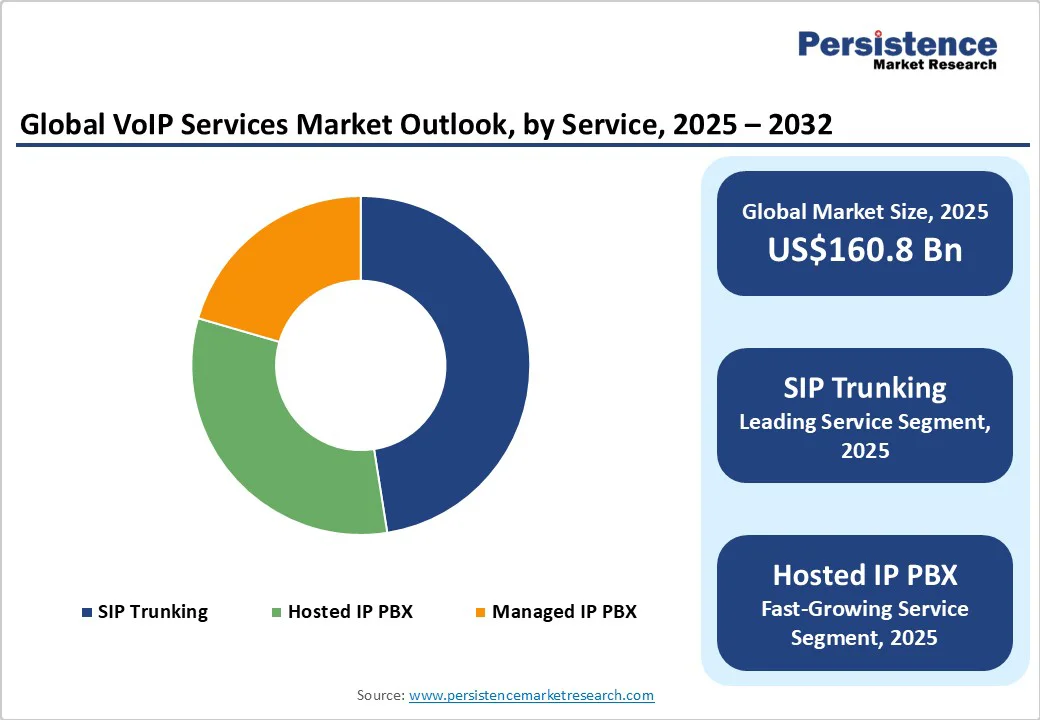ID: PMRREP4710| 196 Pages | 9 Oct 2025 | Format: PDF, Excel, PPT* | IT and Telecommunication

The global VoIP services market size is likely to be valued at US$160.8 Billion in 2025 and is estimated to reach US$340.2 Billion in 2032, growing at a CAGR of 11.3% during the forecast period 2025 - 2032, driven by increasing demand for cost-effective, flexible, and high-quality communication solutions across businesses and consumers. The widespread adoption of cloud-based platforms is another key growth driver.
| Key Insights | Details |
|---|---|
| VoIP Services Market Size (2025E) | US$160.8 Bn |
| Market Value Forecast (2032F) | US$340.2 Bn |
| Projected Growth (CAGR 2025 to 2032) | 11.3% |
| Historical Market Growth (CAGR 2019 to 2024) | 10.5% |

One of the key growth drivers for Voice over Internet Protocol (VoIP) services is their ability to replace costly telephony hardware and complex wiring with a simple internet connection. Businesses no longer need to maintain bulky PBX systems or invest in expensive upgrades every few years, as VoIP solutions can expand virtually with a few clicks.
For instance, small enterprises in Europe are now adopting cloud-hosted VoIP systems that integrate smoothly with CRM tools, eliminating the requirement for standalone phone hardware. This flexibility drastically lowers operational costs while ensuring businesses stay agile and prepared for future technology upgrades.
VoIP has transformed the economics of business communication by making long-distance and international calling much more affordable. Unlike traditional telecom services, which charge per minute and vary by country, VoIP often includes unlimited domestic usage and drastically reduced international rates.
A recent example is start-ups in Southeast Asia adopting VoIP-based platforms such as Zoom Phone and RingCentral to maintain constant communication with clients in the U.S. and Europe without racking up heavy telecom bills. The savings are mainly attractive to SMEs and freelancers, enabling them to broaden their global footprint without worrying about rising phone costs.
The global shift toward remote and hybrid work models has increased the requirement for business communication tools that are not tied to a fixed location. VoIP services allow employees to use their business phone numbers via mobile or desktop apps, ensuring smooth connectivity whether they are at home, in the office, or traveling abroad.
For example, companies in India’s IT sector are now equipping remote teams with VoIP integrations that synchronize with project management tools such as Slack and Microsoft Teams, ensuring constant availability. This mobility not only supports productivity but also improves collaboration across time zones, which is essential in today’s distributed work environments.
VoIP systems rely on internet connectivity, which makes them more vulnerable to security breaches compared to traditional phone lines. Risks such as call interception, denial-of-service attacks, and phishing attempts have become frequent as businesses shift to cloud-based telephony. In 2024, several Europe-based SMEs reported VoIP toll fraud cases where attackers rerouted calls through their systems, leading to significant financial losses.
While providers are strengthening encryption protocols and multi-factor authentication, small firms with limited IT budgets often struggle to implement unique safeguards, leaving them exposed. This ongoing threat remains a key barrier for wide adoption, especially in industries such as finance and healthcare, where confidentiality is important.
Unlike landlines, VoIP services do not inherently provide accurate location tracking, making them less reliable for emergency calls. When a user dials an emergency number, responders may not be able to pinpoint their physical location if they are using VoIP on a mobile device or from a temporary workspace. This gap has drawn regulatory attention in markets such as the U.S., where the FCC has urged VoIP providers to improve their Enhanced 911 (E911) capabilities.
A recent case in Canada exhibited the issue when a VoIP user’s emergency call was delayed because dispatchers could not trace the caller’s location. Such limitations reduce trust in VoIP for urgent situations, specifically among enterprises with mobile or hybrid teams.
The rollout of 5G networks is transforming VoIP performance, bridging the gap between mobile and desk-based communications. With ultra-low latency and high bandwidth, 5G allows crystal-clear voice calls and uninterrupted video conferencing on mobile devices, making VoIP more reliable than ever.
For example, telecom providers in South Korea and Japan have reported a surge in mobile VoIP adoption among SMEs, as employees can now use smartphones or tablets with the same call quality previously limited to office desk phones. This development encourages businesses to adopt fully mobile VoIP strategies, supporting dynamic operations without compromising communication quality.
The rise of Unified Communications as a Service (UCaaS) is bolstering VoIP adoption by integrating voice, video, messaging, and collaboration tools on a single cloud platform. Companies no longer require separate systems for email, conferencing, or phone calls, reducing complexity and operational costs.
For instance, global firms such as Siemens and Shopify are embracing UCaaS solutions from providers, including RingCentral and Microsoft Teams, to improve internal communications and cross-team collaboration. This trend allows businesses of all sizes to expand quickly, adapt to hybrid work environments, and maintain a consistent communication experience across offices and remote locations.
Web Real-Time Communication (WebRTC) technology enables VoIP calls directly through web browsers without additional software or hardware, creating new opportunities for businesses to simplify communications. Online customer support platforms, telehealth services, and e-learning providers increasingly use WebRTC to allow instant, high-quality voice and video calls via websites or apps.
A recent example is the U.K.-based telemedicine start-up Push Doctor, which integrates WebRTC to connect patients and doctors in real time without app downloads. This technology reduces friction for end-users and expands VoIP’s reach, making it accessible to a broad audience.
SIP trunking is estimated to account for nearly 47.5% of the market share in 2025, as it enables businesses to connect their existing phone systems to the internet, replacing costly traditional lines with flexible and expandable connections. SIP trunks also help dynamically adjust bandwidth to match call volume, reducing downtime and improving reliability.
Hosted IP PBX is gaining impetus because it delivers full-featured phone system capabilities without requiring on-site hardware. Businesses can manage calls, voicemail, conferencing, and call routing through the cloud, cutting operational costs and simplifying maintenance.
Large enterprises are expected to account for about 65.3% of the market share in 2025, owing to their requirement for unified, scalable, and secure communication systems across multiple locations. VoIP enables smooth integration with collaboration tools, CRM software, and AI-powered analytics, improving operational efficiency.
SMEs are witnessing steady VoIP adoption as they deliver cost-effective, flexible, and easy-to-deploy communication solutions. SMEs can replace traditional phone lines with cloud-based VoIP systems without heavy infrastructure investments.
The industrial/commercial segment will likely hold a share of approximately 67.2% in 2025, backed by the requirement for integrated communication across large facilities and multiple locations. VoIP enables real-time collaboration, centralized management, and integration with enterprise software such as ERP and CRM.
Residential VoIP adoption is increasing as consumers seek affordable and flexible alternatives to traditional landlines. High-speed broadband availability and the convenience of mobile and desktop apps allow households to make unlimited domestic and cheap international calls.

North America is predicted to lead with a share of approximately 47.4% in 2025, owing to developments in technology and changing communication preferences. Widespread adoption of cloud services, novel telecommunications infrastructure, and increasing popularity of workforce mobility are also expected to drive the regional market.
The U.S. is projected to remain at the forefront of growth with a CAGR of nearly 10.3% through 2032. This is attributed to the rising demand for cost-effective, flexible, and high-quality communication solutions. Key companies, including Cisco Systems, Verizon Communications Inc., and Microsoft Corp., are contributing to the diverse product ranges available to consumers. They are improving services by integrating AI and machine learning into VoIP technology.
VoIP services in Asia Pacific are experiencing considerable growth, pushed by ongoing digital transformation, mobile-first behavior, and expanding internet infrastructure. China, India, and Japan are at the forefront of this expansion, with China leading due to its vast SME base and government-backed digital economy policies. India's booming IT-BPM sector is constantly transitioning to cloud VoIP platforms.
Innovation hubs in Singapore, South Korea, and Japan are pushing forward real-time communication technologies. Asia Pacific is further witnessing an increasing demand for cost-effective, flexible, and high-quality communication solutions. The adoption of cloud-based Unified Communications as a Service (UCaaS) platforms is also contributing to this expansion, as businesses seek integrated communication tools.
VoIP services in Europe are experiencing steady growth due to increasing demand for cost-effective and flexible communication solutions. Businesses across the region are adopting VoIP technologies to improve communication infrastructure, reduce operational costs, and facilitate remote work. The integration of AI into VoIP services is also contributing to market expansion, with AI-based features improving call routing, customer support, and data analytics.
In the residential segment, the adoption of VoIP services is rising, particularly in countries with novel broadband infrastructure and high internet penetration rates. Consumers are increasingly opting for VoIP solutions as an alternative to traditional landlines, attracted by the low costs and additional features delivered by VoIP services.

The global VoIP services market is marked by ongoing technological developments, shifting consumer preferences, and evolving regulatory environments. Zoom, Microsoft Teams, and Google Meet have redefined communication by delivering integrated voice, video, and messaging services. Their user-friendly interfaces and cloud-based infrastructure have attracted both businesses and consumers, challenging traditional telecom providers to innovate and adapt.
VoIP providers focus on innovation, cost leadership, and market expansion to strengthen their positions. Market leaders differentiate through AI-based features, cloud integration, and superior call quality. Emerging trends include subscription-based models, bundled UCaaS offerings, and browser-based WebRTC solutions that simplify access and reduce reliance on traditional hardware.
The VoIP services market is projected to reach US$160.8 Billion in 2025.
Rising demand for cost-effective communication solutions and surging requirements for global connectivity are the key market drivers.
The VoIP services market is poised to witness a CAGR of 11.3% from 2025 to 2032.
Shift toward subscription-based models and increasing demand for real-time browser-based communication are the key market opportunities.
RingCentral, Inc., Microsoft Corporation, and Cisco Systems, Inc. are a few key market players.
| Report Attribute | Details |
|---|---|
| Historical Data/Actuals | 2019 - 2024 |
| Forecast Period | 2025 - 2032 |
| Market Analysis | Value: US$ Bn |
| Geographical Coverage |
|
| Segmental Coverage |
|
| Competitive Analysis |
|
| Report Highlights |
|
By Service
By Enterprise Size
By End-user
By Region
Delivery Timelines
For more information on this report and its delivery timelines please get in touch with our sales team.
About Author